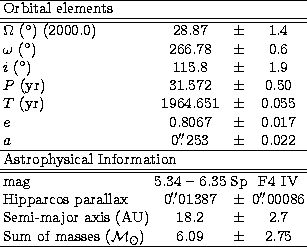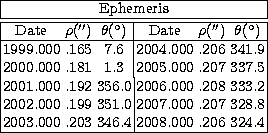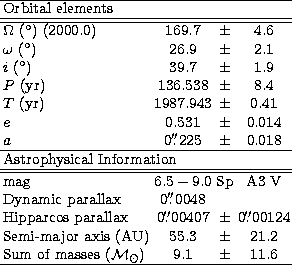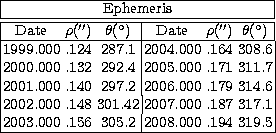The orbital elements are presented below for each couple. WDS identification (equinox 2000) (Mason 1998) is given for each star together with discover name and ADS catalog number. Orbits are plotted in Fig. 3 and Fig. 4. History of all measurements for each star are presented at the end of the paper. We computed eight orbits. Two of them may be considered as reliable (BU 524 and A 1777); a mass estimation and detailed dicussion is given below. Th six others are premature and the orbital elements are summarised in Table 2.

Dynamic parallax (Couteau 1978) could not be computed since star A is not a main-sequence star (spectral class F4IV). This does not agree with published masses of stars A and B estimated from their spectral classes
(Tokovinin 1997): ![]() and
and ![]() . If we suppose that the spectral class F4IV for the primary is well estimated, it might be possible that this system contains other stars to be discovered.
. If we suppose that the spectral class F4IV for the primary is well estimated, it might be possible that this system contains other stars to be discovered.
Van den Bos (1938) calculated two sets of orbital elements, a short period one (P=31.6 yr) and a long period one (P=63.1 yr), the second being justified by quadrant uncertainties and the fact that the observed separation was always greater than
![]() , whereas the short-period orbit predicted a very close periastron of about
, whereas the short-period orbit predicted a very close periastron of about ![]() . We then computed a long period orbit with the following orbital elements: T=1988.066, P=62.851 yr, e=0.0286,
. We then computed a long period orbit with the following orbital elements: T=1988.066, P=62.851 yr, e=0.0286, ![]() ,
, ![]() ,
, ![]() ,
, ![]() . Residuals in separation and in position angle are plotted in
Fig. 2 as a function of time. As can be shown on this
figure and on the orbit plot, this long period orbit does not fit
the observations close to the periastron when the star velocities are high (especially the last speckle measurements). From an astrophysical point of view, the total mass of the system given by this orbit is too small (0.89
. Residuals in separation and in position angle are plotted in
Fig. 2 as a function of time. As can be shown on this
figure and on the orbit plot, this long period orbit does not fit
the observations close to the periastron when the star velocities are high (especially the last speckle measurements). From an astrophysical point of view, the total mass of the system given by this orbit is too small (0.89 ![]() ). This
long period orbit is then to be rejected.
). This
long period orbit is then to be rejected.


Due to large error bars of semi-major axis a and period P, the total mass is very uncertain. For information we found in Tokovinin (1997):

 |
Copyright The European Southern Observatory (ESO)